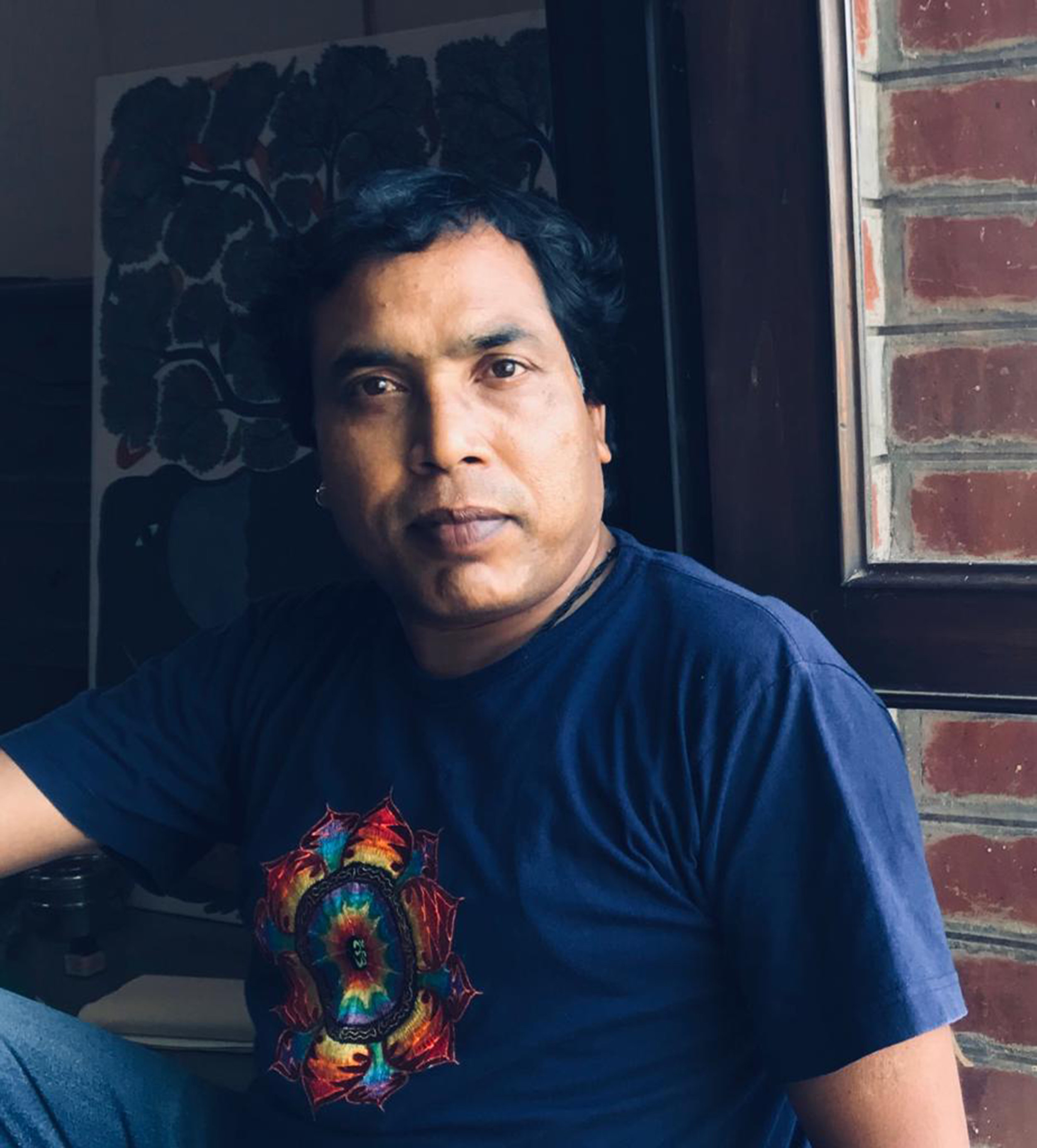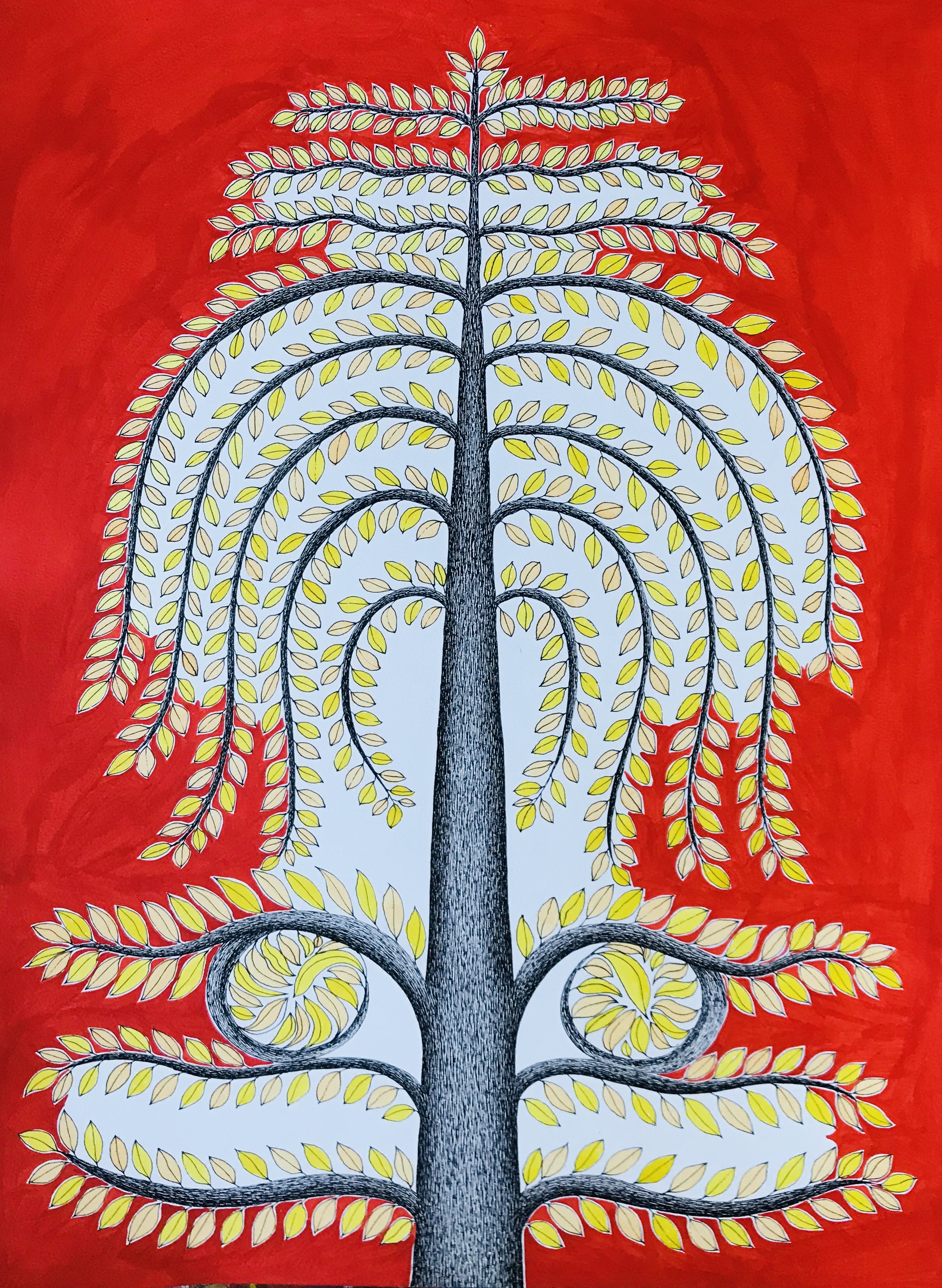Trees give wings
In Delhi for his latest show, Pardhan Gond artist Venkat Raman Singh Shyam whose work focuses on celebrating, worshipping, and protecting greenery, has a strong message for the city
Tulsi Vivah, by Venkat Raman Singh Shyam, acrylic on canvas
The irony is startling to Venkat Raman Singh Shyam: “People want tiny house plants they can place on a table and admire, but don’t want big trees outside...they say the leaves will litter their yard, or roots will creep up their porch,” he says, shaking his head.
We’re in Delhi’s Art Alive Gallery, and the Gond artist’s frames are yet to be mounted for his latest solo, Clouds of Wings. Shyam talks of Delhi’s flora, and how it looks markedly stressed. This confuses me, the Delhi-dweller, who for the last few days has admired the city’s sudden burst into tender green shoots after a recent pre-summer aandhi. He shakes his head, again, saying how roads and pavements are cemented in ways that leave barely any breathing space at the base of tree trunks. “Where will the tree drink rain from, how will its roots breathe?” he asks.
A portrait of the artist
As the gallery staff undo the bubble-wrap on the frames, I notice that most of the 25 pieces that make up the exhibit show trees. “Clouds need wings to fly, and that can only come from good air, from oxygen, and that isn’t possible without trees,” Shyam says, explaining the title of his show. Curated by Ina Puri, the exhibit fittingly opens on Earth Day.
As is the Gond way, Shyam’s work focuses on the intrinsic relationship and the coming together of all living beings in nature: birds, animals, flora, fauna, and sometimes even the sun and moon. One frame, ‘Pakari Tree’ simply depicts an anthromorphised tree with squirrels frolicking around it: its gentle, curving contours are womanly. Perhaps looking at it like that would make us respect the life-force in it, Shyam appears to be saying. “Deep inside, the artist is restless and concerned about the immense environmental crisis we are heading towards,” writes Puri, in her curatorial note.
Like his uncle, Jangarh Singh Shyam, who is credited with the start of a new wave of Indian tribal art, Shyam’s use of colours, especially in some frames of this exhibit, is striking. There is a generous application of blacks that is traditionally illustrative of death or ignorance, and some sharp reds to convey anger, but also attractiveness.
In 'Knowledge Tree’ for instance, there is a black-flecked thin-trunked tree, with pale yellow leaves that are individually, and vulnerably therefore, attached to the blackened branches. The space they grow into is a barren white, while the background hugging the tree is a fiery red.
What Shyam is doing here is noteworthy: The only colour he uses as per its ‘traditional’ symbolism is black. The rest, while keeping with the emotions they’ve long been known to depict, also upturn long-held conceptions: red and yellow especially, the colours of fertility, redolent of bridal trousseaux, are here depicting either anger or the hopeless sadness of no generativity. “Peeliya pata hai na,” he says pointing to the pale quality of the yellow he used here, and using the Hindi name for jaundice. He’s not only communicating with colours — Shyam is also delicately playing with the nuances of their shades.
“Tribal art is otherwise not known for this specific colour-sense,” he says. But sometime in 2007, having attended a workshop lead by senior contemporary Indian artists, he was exposed to colour-communication. Now more than ever, there’s a confidence in how he fuses these concepts into his artistic tradition and sensibility, resulting in arresting works.
A jet black background with a big-eyed sun holding up his hand in blessing, a moon, earth, a string of merry multicolour hangings, and a hop of birds all crowd around an outsized tulsi pot. “The ekadashi after Diwali,” he says, explaining that the eponymous frame illustrates Tulsi Vivah, which happens on the 11th day of the Hindu month of Kartik. Symbolically, the sacred basil is ‘married’ to a Shaligram (an ammonoid fossil in which both Vaishnavite and Shaivite traditions see avatars of the divine) in a syncretic worship of nature and god-forms.
Here, as I prod, he justifies the use of the thick black background, a colour so strongly depicting death in his other frames, as the night sky that leads us to the dawn of knowledge. “Celebrate and worship your greenery,” is Shyam’s simple message. Years ago, when looking for work in Delhi, Shyam would pedal rickshaws. He remembers passing by a number of champa trees dotting the AIIMS flyover circle.
“Where are they now? Did they need to go, in favour of metallic installations? Delhi really takes its greenery for granted,” he says, warning that “in another 25-30 years all this will dry up.” A good reminder on Earth Day.
This piece was first published here



